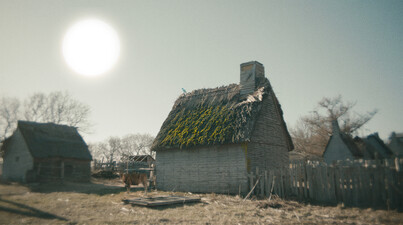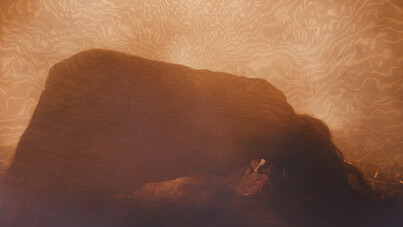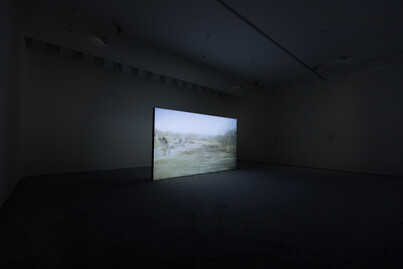Rachel Rose
by Philomena Epps
Reviews /
Exhibition
• 03.12.2018
Rachel Rose’s video installation Wil-O-Wisp (2018) is one of four exhibitions currently on show at the Fondazione Sandretto Re Rebaudengo (FSRR) in Turin (alongside presentations from Monster Chetwynd, Lynette Yiadom-Boakye and Andra Ursuta). Wil-o-Wisp is the inaugural Future Fields Commission in Time-Based Media, which is a new partnership between FSRR and the Philadelphia Museum of Art that supports innovation in research by emerging artists. Wil-o-Wisp is Rose’s sixth film work, and situates her moving image practice within a new context, that of historical fiction. The ten-minute film is set in rural England at the turn of the seventeenth century, and follows the character of Elspeth Blake, a mystic and a healer. Her story is framed by the broader issues of the period: the enclosure of common lands, the persecution of women, and the divisions between the rationality of early modernity and the animist and superstitious attitudes within folklore.
Elspeth is a conflation of multiple women Rose read about in various historical documents from the English agrarian period, in addition to records about the socio-political effects of the enclosure movement. Set in Somerset in 1570, the film opens with images of Elspeth working on the land and with her family. One night, her daughter sneaks out, drops her bonnet next to the fire and burns down their cottage. When the bodies are recovered, Elspeth’s is not there. She is then seen to enter the nearby village of Stogursey in 1603, becoming known for her healing powers. Elspeth is spied on by the local prefect while reviving a man from his sick bed, which results in her expulsion from the village on charges of witchcraft.
When the film ends, it cuts sharply and loops back immediately. Chapters are marked by captions in the style of anthropomorphic illuminated manuscript initials FIG.1. There is no dialogue and the narrative is broken into three fragments, first with the instrumental score ‘Blue Shadows and Purple Hills’, which was originally written for the 1960 film Spartacus – ‘It’s a highly emotional, orchestral score for the landscape. It felt so in line with this 1600s animist perspective’ – then a female voiceover, and finally by song.1 To compose the song, Rose transformed the narrative events into lyrics in iambic pentameter and worked with a historian who had researched melodies and chants from the period. Rose collaborated throughout the project. The aforementioned healing sequence was developed with healer and art historian Diana Mellon, whose research has looked into healing practices of the time and the ritual of transference between beings FIG.2.
Early in her research for the film, Rose became interested in theories behind coincidence and chains of being. In her published conversation with Erica F. Battle, curator at the Philadelphia Museum of Art, she cites Shakespeare’s use of coincidence in his storytelling as well as Carl Jung’s Synchronicity (1960) and Arthur Lovejoy’s essay ‘The Great Chain of Being’ (1936).2 Lovejoy considered all beings and objects as part of a hierarchical, interconnected system that culminated in God, and while the system has its roots in Antiquity, it was more fully developed in the seventeenth century. Similarly, Rose presents an understanding of history that is stratified and non-linear, with multiple overlapping temporalities coalescing within the film. The concept of history as an invention or fiction is exemplified by her decision to shoot the film at the Living History Museum at Plimoth Plantation, an English-style colonial settlement in Massachusetts FIG.3. The meshing of the past and present tense at Plimouth Plantation results in a surreal suspension of time, meaning that history is able to be embodied and lived out in our current moment.
Rose’s initial use of a straightforward single shot tableaux is deceiving, with her postproduction editing becoming a kind of alchemy, creating varying levels of distortion, such as the rippled Moiré effect FIG.4, which warps the focus of the image. The dreamlike nature of Wil-O-Wisp is carefully extended by the specificity of the viewing environment at FSRR. The large screen is placed at the centre of the room, the floor is covered in thick white carpet, with a translucent scrim material covering the four walls that produces a Moiré effect, mirroring that of the film as well as distorting the real depth and height of the space FIG.5.
‘Will-o’-the-wisp’, or ignis fatuus, meaning ‘foolish fire’, was the name given to the phosphorescent light often seen across a marsh or bog. While the light is now understood to be a natural phenomenon, according to popular belief these apparitions were the work of wicked fairies leading travellers astray. The phrase ‘foolish fire’ is used to describe anything deliberately misleading, an impossible target, or having a skewed perception of events. A similar oscillation between reality and fantasy runs throughout the film: details of the landscape are highlighted in an eerie Technicolour (a glowing red moon, luminous green moss, a shimmering blue bird, a cloud of purple fog), and a rear projection screen depicts multiple landscapes in one frame.
In her catalogue essay, Erika Balsom writes how these effects ‘signify the presence of otherworldly spirits in addition to imparting an aura of enchantment and plasmatic transformation, but they also distance the viewer from any impression of reality, underlining the artifice of this reconstructed 17th century’.3 Through the doubling of screens – akin, perhaps, to the Shakespearian device of a play within a play – Rose shows Elspeth as having two co-existing temporalities. Elspeth crouches below the rear projection screen to gather grains while the overhead song expands on the various charges of witchcraft against her, these scenes are then depicted on the screen, as if happening within a parallel reality or concurrent living history. By showing two narratives, the viewer is unsure in which reality Elspeth’s expulsion from Stogursey occurred, as the screen then quickly cuts in favour of fuzzy black-and-white footage showing the dance of the fairies, derived from a 1935 adaptation of ‘A Midsummer Night’s Dream’: a reference to another of Rose’s research interests, early forms of anti-realist cinema. Through theoretical and textural layers, the viewer’s body is both transformed and disorientated by Wil-O-Wisp. The film itself becomes a translucent object, which deliberately evades one temporality or truth, but leaves subtle clues or references as it unfolds, before disappearing quickly, like a mirage.









